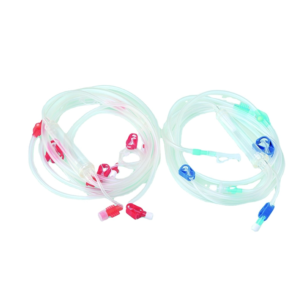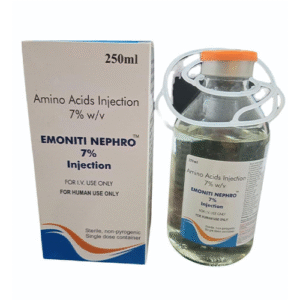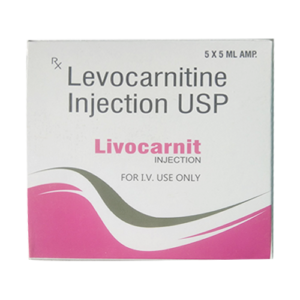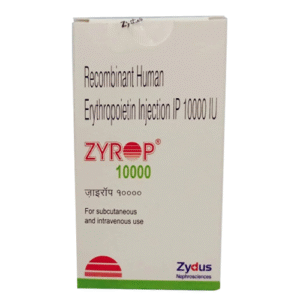Double Lumen & PermCath Catheters
Double Lumen & PermCath Catheters
To filter the patient blood, Dialysis Patient’s need a vascular access. Double Lumen comes in two different variant temporary or permanent vascular accesses. Temporary access can be created instantly for emergency Dialysis Treatment whereas Permanent vascular access needs a minor surgery for long term durability.
What Do You Need Today
Hemodialysis Blood Line Set
What is a Hemodialysis Blood Line Set?
The blood line set (also called blood tubing set) is the connecting pathway between the dialyzer, the dialysis machine, and the patient's vascular access (like an AV fistula or catheter). It’s a critical disposable component used during each dialysis session.
Main Functions
-
Carries blood from the patient to the dialyzer (via the arterial line).
-
Returns cleaned blood from the dialyzer back to the patient (via the venous line).
-
Interfaces with the dialysis machine for pressure monitoring, air detection, and heparin infusion.
Components of a Standard Blood Line Set
Arterial Blood Line (Red)
-
Connects to the arterial needle (or catheter).
-
Carries blood from patient to dialyzer.
-
Includes:
-
Drip chamber (monitors blood flow & traps air)
-
Sampling port (for blood samples or medication)
-
Heparin port (for anticoagulant infusion)
-
Pump segment (goes through the blood pump)
-
Venous Blood Line (Blue)
-
Connects to the venous needle.
-
Returns cleaned blood from dialyzer to patient.
-
Includes:
-
Venous drip chamber (air trap + bubble detector)
-
Venous sampling/med port
-
Clamp & luer lock connector
-
Other Features
-
Sterile, single-use.
-
Made from PVC (polyvinyl chloride), often DEHP-free for safety.
-
Tubing diameter must match machine specs and blood flow rate needs.
Types of Blood Line Sets
| Type | Used With | Notes |
|---|---|---|
| Standard HD Set | Conventional hemodialysis machines | Most common |
| Low Volume Set | Pediatric or low-weight patients | Minimizes extracorporeal volume |
| Pre-attached Set | Comes with dialyzer | Reduces setup time, contamination risk |
| High-Flux Compatible | High-efficiency dialyzers | Optimized for higher blood flows |
Clinical Considerations
-
Always check for kinks, leaks, or expired sterile packaging.
-
Prime tubing set thoroughly to remove air before connecting to patient.
-
Observe arterial/venous pressure alarms, as issues may relate to tubing occlusion or misconnection.
-
Match tubing set to machine brand/model (e.g., Fresenius, B. Braun, Nipro, etc.).
Final Summary
A Hemodialysis Blood Line Set is a vital, sterile tubing system that safely and efficiently moves blood between the patient, machine, and dialyzer. It's essential for:
-
Blood flow control
-
Monitoring
-
Anticoagulation delivery
-
Maintaining a closed-loop sterile system
Liquid 7% Amino Injection
What is Liquid Amino Acid 7%?
Liquid Amino Acid 7% is a sterile medical nutritional supplement designed to provide both essential and non-essential amino acids. It plays a vital role in supporting the nutritional needs of dialysis patients, especially those at risk of protein-energy malnutrition due to chronic kidney disease (CKD).
Why is it Used in Dialysis?
Patients undergoing hemodialysis or peritoneal dialysis often lose important proteins and amino acids during treatment. Additionally, reduced appetite is common, which limits dietary protein intake. Supplementing with amino acids helps to:
-
Prevent muscle wasting
-
Improve nitrogen balance
-
Support wound healing and immune function
-
Maintain serum albumin levels, which are key indicators of nutritional health
What’s Inside Liquid Amino Acid 7%?
The “7%” in the name indicates that the solution contains 7 grams of amino acids per 100 mL. The precise amino acid profile may vary by manufacturer but typically includes:
Essential Amino Acids:
-
Leucine
-
Isoleucine
-
Valine
-
Lysine
-
Methionine
-
Phenylalanine
-
Threonine
-
Tryptophan
Non-Essential Amino Acids:
-
Alanine
-
Glycine
-
Glutamine
-
Arginine
-
Others depending on formulation
How is it Administered?
-
Typically given intravenously (IV) during or shortly after dialysis sessions
-
Dosage is determined by a physician, based on the patient's nutritional status, laboratory values, and overall health condition
Important Clinical Considerations
-
Must be used under medical supervision only
-
It is a supplement, not a substitute for dietary protein
-
Requires careful monitoring of the patient’s fluid balance, electrolyte levels, and urea load to prevent complications
Final Summary
Liquid Amino Acid 7% is an important adjunct to nutritional therapy for patients undergoing dialysis. It helps combat protein deficiency, supports recovery, and contributes to better outcomes by ensuring the body gets the building blocks it needs — safely and effectively, as part of a comprehensive medical plan.
Levocarnitine and Amino Acids
What is Livocarnit Injection (L-Carnitine)?
Livocarnit Injection is a sterile formulation of L-carnitine, a naturally occurring compound essential for the transport of long-chain fatty acids into mitochondria for energy production. It is particularly beneficial in supporting muscle energy metabolism, especially in cardiac and skeletal muscles, and is often used as a supplement in chronic hemodialysis patients.
Why is it Used in Dialysis Patients?
Patients undergoing chronic dialysis may experience L-carnitine deficiency due to multiple factors including:
-
Dialysis-related loss of carnitine during sessions
-
Impaired endogenous synthesis due to kidney dysfunction
-
Reduced dietary intake
In such cases, Livocarnit Injection may be used to help manage:
-
Muscle weakness and cramps
-
Low energy and chronic fatigue
-
Cardiac dysfunction, including cardiomyopathy
-
Erythropoietin-resistant anemia, by enhancing the response to EPO therapy
Administration and Dosage
-
Administered intravenously, typically after dialysis sessions
-
Dosage is determined by the physician based on clinical symptoms and lab parameters
-
Treatment is usually reserved for patients with confirmed carnitine deficiency
Clinical Considerations
-
Serum carnitine levels (free and total) may be measured to assess need
-
Supplementation is not recommended for all dialysis patients, only those with clear clinical indications
-
Monitor for potential drug interactions or worsening of underlying conditions
-
Effectiveness may vary depending on individual patient status
Possible Side Effects
-
Common side effects: nausea, vomiting, diarrhea
-
May cause fishy body odor due to trimethylamine accumulation
-
Rare side effects: seizures or arrhythmias, especially in predisposed individuals
Final Summary
Livocarnit Injection (L-Carnitine) is a targeted therapy for dialysis patients experiencing symptoms associated with carnitine deficiency. It supports muscle energy, cardiac health, and response to anemia treatment, making it a valuable clinical tool when used appropriately under medical supervision.
EPO,s 4K to 10K I.U
What is EPO (Erythropoietin)?
Erythropoietin (EPO) is a hormone responsible for stimulating red blood cell production in the bone marrow. In patients with chronic kidney disease (CKD), especially those on hemodialysis, the kidneys fail to produce enough EPO, leading to anemia. To correct this, recombinant forms like Epoetin alfa, Darbepoetin alfa, or CERA are commonly used.
Why is it Used in Dialysis?
Anemia is a frequent complication in dialysis patients due to impaired erythropoietin production, iron deficiency, and frequent blood loss during treatment. Supplementing with EPO helps:
-
Restore and maintain hemoglobin (Hb) levels
-
Improve oxygen delivery to tissues
-
Reduce the need for blood transfusions
-
Enhance patient energy and quality of life
Typical Dose Range: 4,000–10,000 IU
This dose range is considered standard for maintenance therapy in hemodialysis patients. It is adjusted based on patient-specific factors and hemoglobin response. EPO can be administered 1 to 3 times per week, either intravenously (IV) post-dialysis or subcutaneously (SC) in select cases.
| Dose Range | Frequency | Route | Purpose |
|---|---|---|---|
| 4,000–6,000 IU | 1–3 times/week | IV or SC | For stable Hb around 10–11.5 g/dL |
| 7,000–10,000 IU | 1–2 times/week | IV or SC | For patients with low Hb or EPO resistance |
Target Hemoglobin Range
-
Ideal Hb levels are 10–11.5 g/dL
-
Levels above 12 g/dL are avoided due to risk of thrombosis, hypertension, and cardiovascular events
-
Adjustments to dosing are based on regular Hb monitoring
When Higher Doses May Be Needed
Higher doses (up to or above 10,000 IU) may be required in cases of:
-
EPO resistance from inflammation or infection
-
Iron deficiency, despite supplementation
-
Blood loss, recent surgery, or inadequate dialysis
-
Secondary hyperparathyroidism, affecting erythropoiesis
Key Factors to Monitor Before Dose Adjustments
-
Iron parameters – Ferritin > 200 ng/mL, TSAT > 20%
-
Signs of inflammation or infection
-
Dialysis adequacy – Kt/V ≥ 1.2
-
PTH levels – To rule out bone marrow suppression
Summary
Erythropoietin 4,000–10,000 IU is a critical therapy for managing anemia in hemodialysis patients. The dose is tailored to each patient’s hemoglobin levels, response, and clinical condition. Effective use requires close monitoring, proper iron supplementation, and adjustment based on treatment goals and guideline recommendations.





















